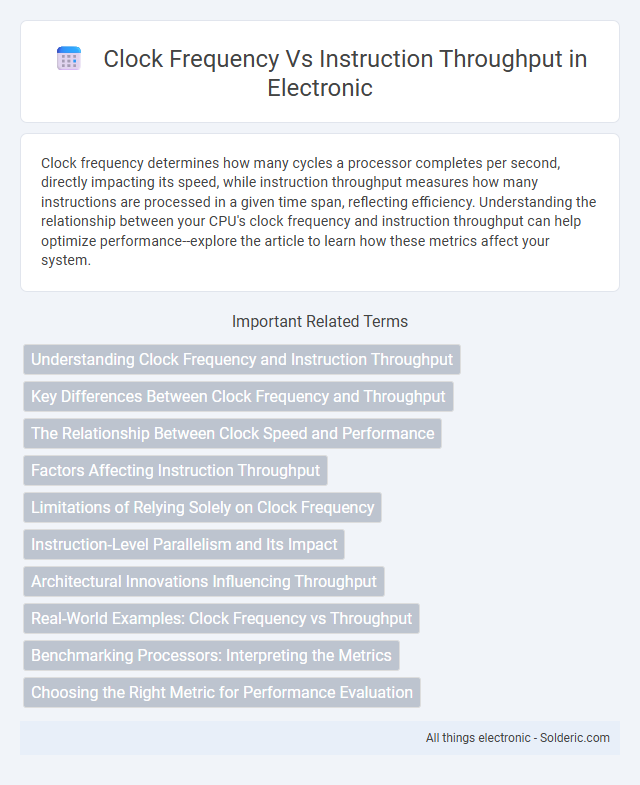Clock frequency determines how many cycles a processor completes per second, directly impacting its speed, while instruction throughput measures how many instructions are processed in a given time span, reflecting efficiency. Understanding the relationship between your CPU's clock frequency and instruction throughput can help optimize performance--explore the article to learn how these metrics affect your system.
Comparison Table
| Aspect | Clock Frequency | Instruction Throughput |
|---|---|---|
| Definition | Number of clock cycles per second (Hz) | Number of instructions executed per unit time |
| Unit | Hertz (Hz) | Instructions per second (IPS) |
| Indicates | Speed of the processor's clock | Effective rate of instruction execution |
| Dependency | Independent of instruction complexity | Depends on CPU architecture, pipeline, and IPC |
| Optimization goal | Increase clock speed for faster cycle times | Improve instruction-level parallelism and pipeline efficiency |
| Typical range | GHz range (e.g., 2.5 GHz to 5 GHz) | Millions to billions of instructions per second |
| Limitations | Power consumption and thermal limits | Bottlenecks from memory latency and hazards |
Understanding Clock Frequency and Instruction Throughput
Clock frequency measures how many cycles a processor completes per second, directly impacting the speed at which instructions are processed. Instruction throughput refers to the number of instructions a CPU can execute within a given time frame, influenced by factors like pipeline depth and instruction-level parallelism. Understanding the balance between clock frequency and instruction throughput helps optimize your system's performance by ensuring efficient use of processing cycles and execution resources.
Key Differences Between Clock Frequency and Throughput
Clock frequency measures the number of cycles a processor completes per second, typically in GHz, directly impacting the speed of individual operations. Instruction throughput represents the number of instructions a processor can execute in a given time frame, influenced by factors such as pipeline depth, parallelism, and architecture efficiency. While higher clock frequency can boost speed, throughput provides a more comprehensive measure of overall CPU performance, helping you evaluate how efficiently your processor handles workload.
The Relationship Between Clock Speed and Performance
Clock frequency directly influences the number of cycles per second a processor can execute, impacting instruction throughput and overall performance. Higher clock speeds typically increase the rate at which instructions are processed, but diminishing returns occur due to factors like pipeline stalls, memory latency, and energy consumption. Balancing clock speed with architectural efficiency, such as instruction-level parallelism and cache optimization, is critical for maximizing performance beyond raw frequency alone.
Factors Affecting Instruction Throughput
Instruction throughput depends on several factors including clock frequency, pipeline depth, and the efficiency of instruction decoding and execution units. Higher clock frequency can increase the rate at which instructions are processed, but pipeline hazards, memory latency, and resource conflicts often limit overall throughput. Optimizing Your processor's architecture by balancing clock speed with these factors ensures better performance and maximizes instruction throughput.
Limitations of Relying Solely on Clock Frequency
Clock frequency measures how many cycles a processor completes per second but does not directly determine instruction throughput, which depends on factors like pipeline efficiency, instruction-level parallelism, and execution units. Relying solely on clock frequency ignores bottlenecks such as memory latency, cache misses, and branch mispredictions that can reduce actual throughput. To optimize Your system's performance, consider architecture improvements and instruction-level optimizations alongside frequency enhancements.
Instruction-Level Parallelism and Its Impact
Instruction-level parallelism (ILP) enhances instruction throughput by allowing multiple instructions to execute simultaneously within a CPU cycle, effectively increasing performance without solely relying on higher clock frequencies. Techniques like pipelining, superscalar execution, and out-of-order dispatch exploit ILP by overlapping instruction execution stages, reducing stalls and latency. Consequently, ILP optimization improves throughput more efficiently than simply increasing clock frequency, as it maximizes resource utilization and minimizes execution bottlenecks.
Architectural Innovations Influencing Throughput
Architectural innovations such as superscalar designs, out-of-order execution, and pipeline depth significantly impact instruction throughput by enabling multiple instructions to be processed simultaneously or more efficiently within a single clock cycle. Techniques like register renaming and branch prediction reduce stalls and hazards, further enhancing throughput independent of clock frequency. These advancements optimize resource utilization and instruction-level parallelism, driving higher throughput without solely relying on increasing clock speed.
Real-World Examples: Clock Frequency vs Throughput
Real-world examples illustrate that higher clock frequency does not always equate to greater instruction throughput due to architectural differences like pipeline depth and instruction-level parallelism. Modern processors, such as ARM's big.LITTLE architecture, balance clock speed with efficient throughput by dynamically switching cores based on workload demands. Understanding how your device's clock frequency interacts with its throughput can help optimize performance for specific applications.
Benchmarking Processors: Interpreting the Metrics
Clock frequency, measured in gigahertz (GHz), indicates how many cycles a processor executes per second, directly impacting the speed of each operation. Instruction throughput, often expressed as instructions per cycle (IPC), reflects the efficiency with which a CPU processes instructions during each clock cycle. Benchmarking processors involves analyzing both metrics together, as higher clock frequency does not necessarily mean better performance if instruction throughput is low, highlighting the importance of balancing these values for accurate performance interpretation.
Choosing the Right Metric for Performance Evaluation
Clock frequency measures the number of cycles a processor completes per second, while instruction throughput quantifies the number of instructions executed within a given time frame. Evaluating performance using instruction throughput provides a more accurate indication of real-world efficiency, especially in superscalar or pipelined architectures where multiple instructions are completed per cycle. Selecting instruction throughput as the primary metric enables better optimization of processor designs and software performance.
clock frequency vs instruction throughput Infographic

 solderic.com
solderic.com